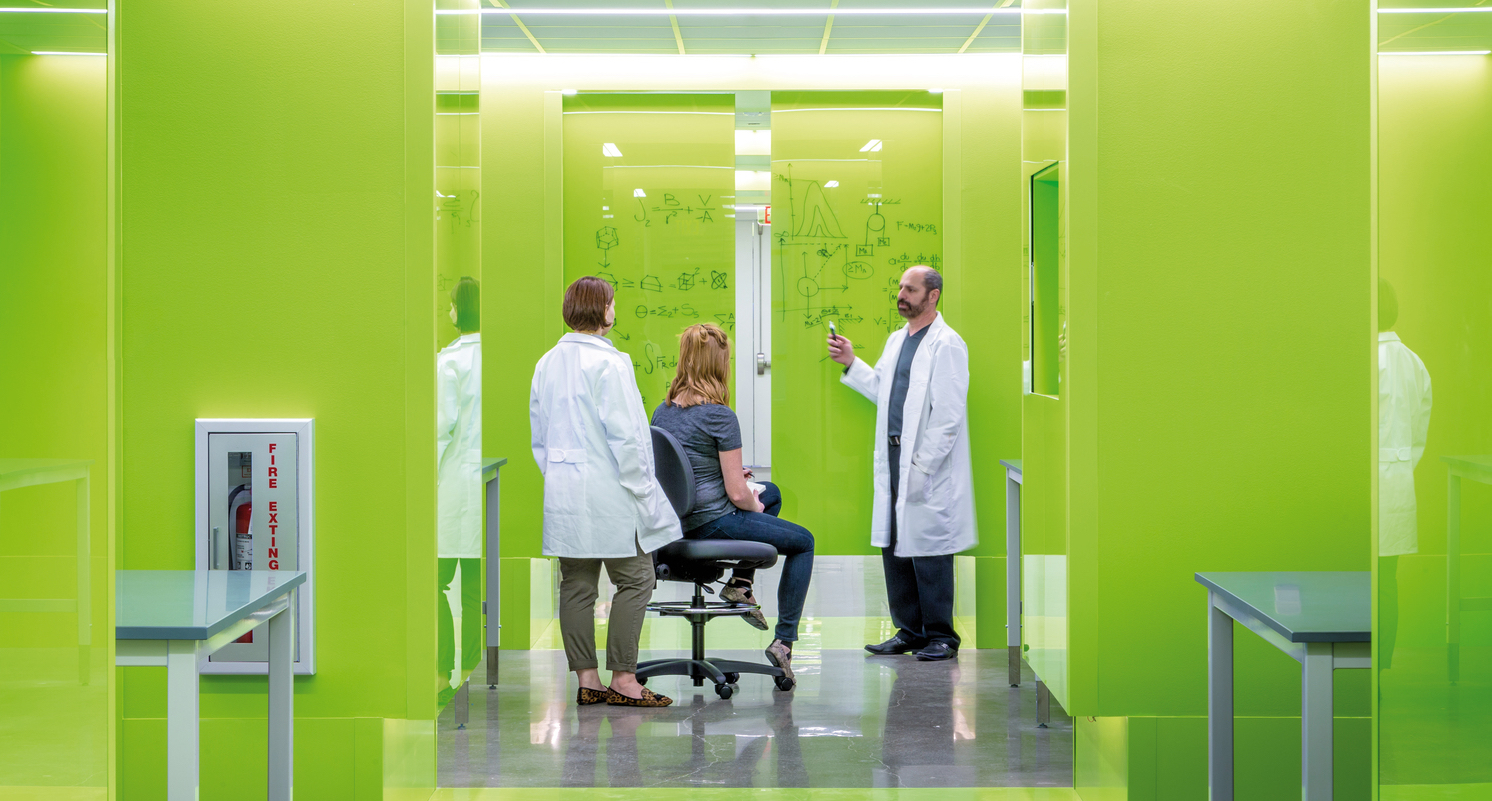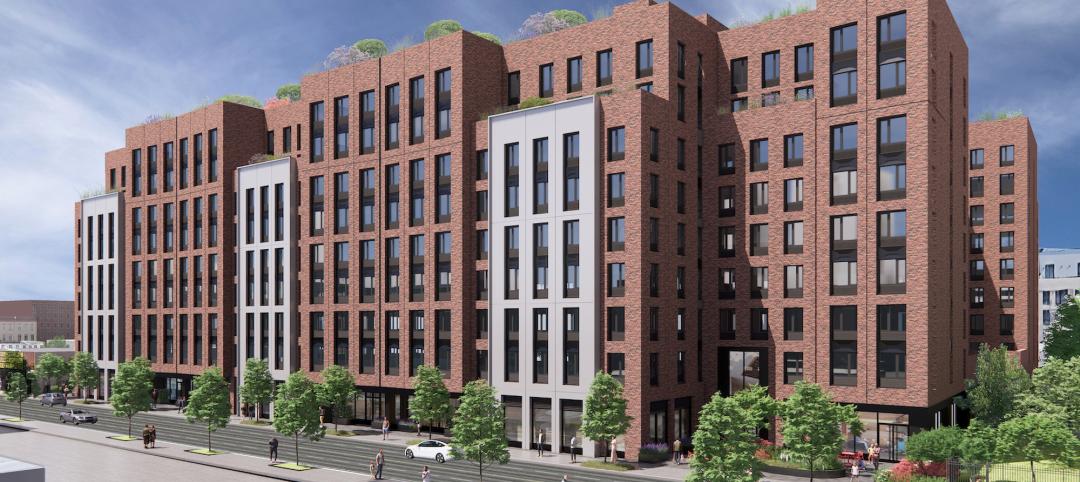The 21st century has seen remarkable healthcare breakthroughs. These advances are largely driven by the speed at which organizations can translate scientific discoveries to applications that benefit patients and communities. Whereas this process has traditionally been slow and cumbersome, today’s organizations are rethinking their business models and environments to ensure they support each other and generate faster and better outcomes.
But simply putting researchers and clinicians in the same building with hopes that serendipitous collaborations will ensue will often not yield the outcomes organizations seek. Based on our experience, we have found that success often depends on building an open innovation ecosystem — a living lab that integrates concurrent research and innovation processes with patient care.
This takes traditional translational health science environments to new levels by making them more permeable and better capitalizing on inter- and intra-disciplinary approaches within and outside of the organization. These ecosystems are not only optimized to support health and research collaborations but partnerships with academia, foundations, pharmaceutical companies, biotech firms, start-ups and more.
 Gates Vascular Institute and UB’s Clinical and Translational Science Institute
Gates Vascular Institute and UB’s Clinical and Translational Science Institute
You can imagine the different flows of knowledge and communication that occur in such a complex environment made up of different people, approaches and goals. Although the ways people capture knowledge and convert it to answers will always be complex and varied, we have developed six key strategies established through precedent and research that create consistent interaction and knowledge exchange within these new translational environments.
1. Focus on proximity. Research shows the average frequency of person-to-person interaction drops by half when separated from 15 to 50 feet, and half again from 50 to 150 feet. All to say, the importance of physical proximity cannot be understated when it comes to sharing knowledge and speeding up complex processes. Although housing everyone on the same floor is always ideal, if it’s not possible, visual and physical connections such as open stairs between floors can play a big role in enhancing proximity. As an example, at the Novartis-Penn Center for Advanced Cellular Therapies (CACT) in Philadelphia — an environment focused on groundbreaking research that enables a patient’s own immune cells to be reprogrammed in the lab and re-infused to hunt and destroy tumors — locating scientists and technicians on the same floor and within close proximity to the greater University of Pennsylvania campus helped reduce the time it takes to create “hunter cells” for patients by 50 percent.
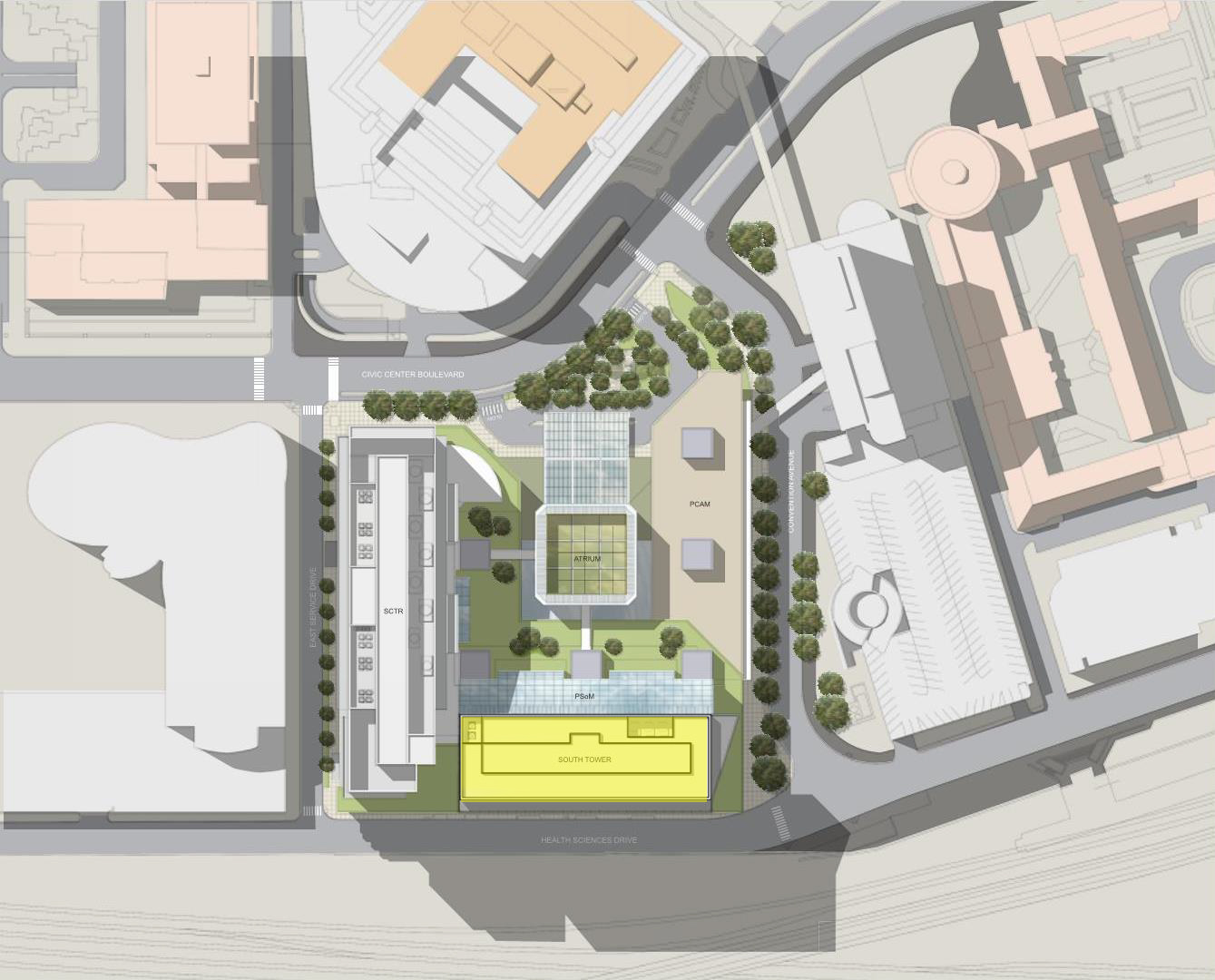 The CACT (located in the South Tower, highlighted) is completely interconnected to the larger immunotherapy program at Penn Medicine and enveloped by the greater university campus.
The CACT (located in the South Tower, highlighted) is completely interconnected to the larger immunotherapy program at Penn Medicine and enveloped by the greater university campus.
2. Find inspiration in urban life. If you look at the city or community you live in, you’re likely drawn to certain places for specific purposes. You go to parks for fresh air, bars and restaurants to unwind, museums to experience culture, etc. These destinations draw people out of the comfort of their homes to interact with the world around them. This same mindset can make a big difference when trying to encourage researchers and clinicians to leave their comfort zone to interact with others. So rather than looking at the environment as a workplace, we look at it as if it were a micro city with connections (pathways and circulation routes), culture and destinations (atriums, collaboration areas, outdoor spaces), neighborhoods (hubs housing specific types of research), and services (shared technology areas, cafes, coffee zones). This approach turns workplaces into micro-cities that naturally bring disparate people together and bring greater awareness into an organization. Read more on this strategy, here.

3. Employ a Kit of Parts. In translational settings, we always advocate for providing numerous options calibrated to different types of workstyles and preferences. We have found that employing a kit of parts — typically a collection of modular spaces supporting various types of work — provides the flexibility needed to maximize the productivity of collaboration and “heads down” time. It also fosters an open innovation platform through its ability to provide space for visiting teams, outside alliances or internal novel partnerships. The modularity of these parts allows for change; configurations can shift regularly to provide the varied experiences that keep innovation and creativity fresh.
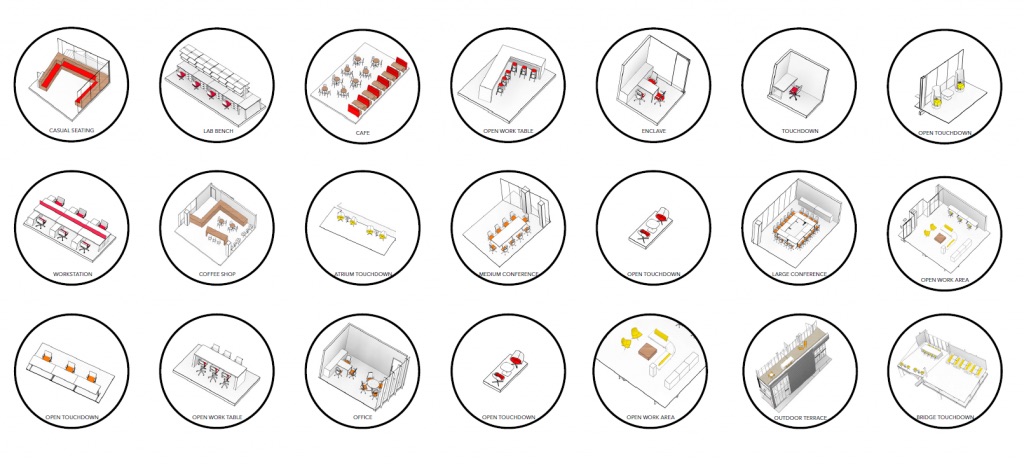 Example kit of parts
Example kit of parts
4. Use the workplace as a living laboratory. The scientific process is driven by experimentation. This same mindset should be applied to translational areas. Although we always conduct in-depth research on human behavior and space utilization before designing a workplace, sometimes the needs of occupants change, or they don’t translate to the work environment as originally planned. But if the work environment is designed as a living laboratory intended to continually change, that’s OK! Once the space is open, we can gather data in several ways— for example, employing sensors to track actual activity and observing occupants using the space — to learn more about what’s working and what might need to be changed.
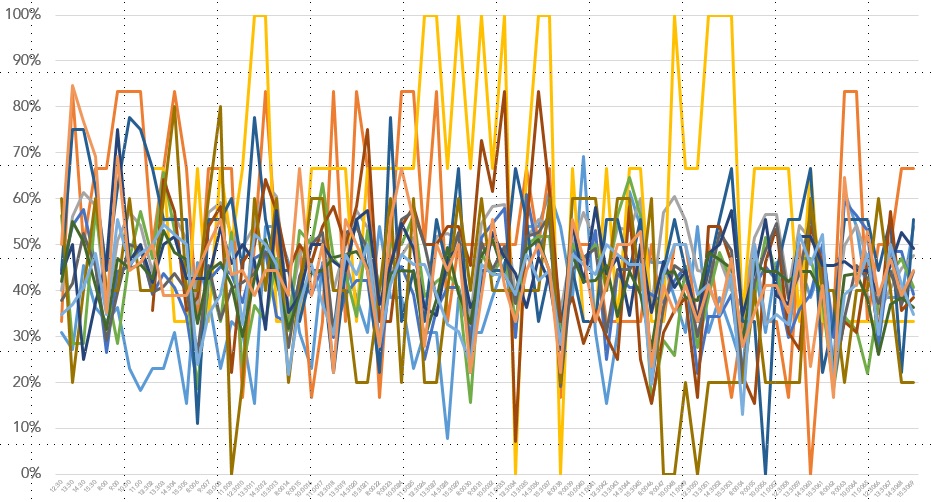 Actual workplace utilization analysis
Actual workplace utilization analysis
5. Design for lingering. Whereas creating shared spaces is important in uniting individuals and teams, the success of these spaces often depends on the interactions that unfold within them. To increase interactions, we leverage utilization data to predict what spaces (and what characteristics of spaces) might lend themselves to lingering. For instance, our data suggests that enclosed collaborative spaces can be anywhere from 3x-10x more intensively utilized than open collaborative areas — depending on the organization. This data can help us better understand why people prefer lingering in these enclosed spaces and how we can prompt similar utilization in other areas throughout the workplace.
6. Encourage collaboration, but keep a keen eye on distraction. Many workplaces today function as distraction factories, and according to a University of California, Irvine study, it takes an average of 23 minutes and 15 seconds to get back to a task after you’ve been distracted. In workplaces for translational health science, open collaborative environments without opportunities to “escape” are guaranteed to lead to distraction. Our kit of parts concept also provides variety in the configuration of the workplace to enable individuals to work in areas that best support the type of work they’re focused on during any given day.
Although the research unfolding in translational health science facilities is complex, designing workplaces that foster the type of knowledge transfer so critical to their success doesn’t need to be. By understanding what it takes to design environments that prompt authentic collaboration, purposeful integration, open innovation, and create a healthy, happy and productive work experience, we can create workplaces precisely calibrated to translate ideas and research into tomorrow’s healthcare breakthroughs.
More from Author
CannonDesign | Jan 3, 2024
Designing better built environments for a neurodiverse world
For most of human history, design has mostly considered “typical users” who are fully able-bodied without clinical or emotional disabilities. The problem with this approach is that it offers a limited perspective on how space can positively or negatively influence someone based on their physical, mental, and sensory abilities.
CannonDesign | Oct 23, 2023
Former munitions plant reimagined as net-zero federal workplace
The General Services Administration (GSA) has embraced adaptive reuse with Building 48, an exciting workplace project that sets new precedents for how the federal government will approach sustainable design.
CannonDesign | Aug 22, 2023
How boldly uniting divergent disciplines boosts students’ career viability
CannonDesign's Charles Smith and Patricia Bou argue that spaces designed for interdisciplinary learning will help fuel a strong, resilient generation of students in an ever-changing economy.
CannonDesign | Jul 10, 2023
The latest pediatric design solutions for our tiniest patients
Pediatric design leaders Julia Jude and Kristie Alexander share several of CannonDesign's latest pediatric projects.
CannonDesign | May 11, 2023
Let's build toward a circular economy
Eric Corey Freed, Director of Sustainability, CannonDesign, discusses the values of well-designed, regenerative buildings.
CannonDesign | Apr 10, 2023
4 ways designers can help chief heat officers reduce climate change risks
Eric Corey Freed, Director of Sustainability, CannonDesign, shares how established designers and recently-emerged chief heat officers (CHO) can collaborate on solutions for alleviating climate change risks.
CannonDesign | Mar 9, 2023
5 laboratory design choices that accelerate scientific discovery
Stephen Blair, director of CannonDesign's Science & Technology Practice, identifies five important design strategies to make the most out of our research laboratories.
CannonDesign | Feb 9, 2023
3 ways building design can elevate bold thinking and entrepreneurial cultures
Mehrdad Yazdani of CannonDesign shares how the visionary design of a University of Utah building can be applied to other building types.
CannonDesign | Jan 9, 2023
How modular solutions can help address skyrocketing construction costs
Modular builder Joshua Mensinger details three ways modular solutions aid in lowering construction costs.
CannonDesign | Dec 9, 2022
What's old is new: Why you should consider adaptive reuse
While new construction allows for incredible levels of customization, there’s no denying that new buildings can have adverse impacts on the climate, budgets, schedules and even the cultural and historic fabrics of communities.

